The Augmented Cantitruncated 5-cell
The augmented cantitruncated 5-cell is a CRF polychoron produced by augmenting the cantitruncated 5-cell with a tetrahedral canticupola (K4.76). It is notable for having 6 gyrobifastigium (J26) cells, in addition to 6 truncated tetrahedra, 4 hexagonal prisms, 4 truncated octahedron, 4 triangular cupolae, and 4 triangular prism, for a total of 28 cells, 118 polygons (36 triangles, 48 squares, 34 hexagons), 162 edges, and 72 vertices.
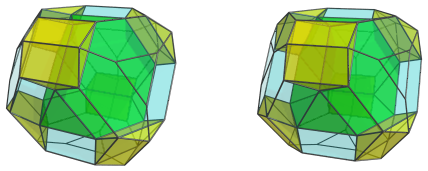
The gyrobifastigium cells are produced from 6 pairs of triangular prisms from the augment and the cantitruncated 5-cell, respectively, that happen to lie on the same hyperplanes, thereby merging into gyrobifastigia.
Structure
We shall explore the structure of the augmented cantitruncated 5-cell by means of its parallel projections into 3D, centered on the truncated tetrahedron cell that touches the 6 gyrobifastigium cells.
The Near Side
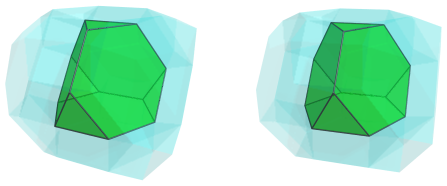
The above image shows the truncated tetrahedron cell. It is nearest to the 4D viewpoint. For clarity, we have rendered the other cells in a light transparent color.
Four hexagonal prisms surround this nearest cell, as shown next:
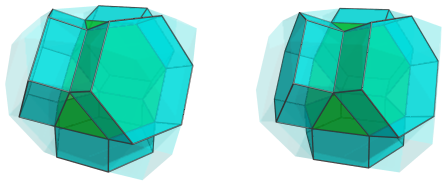
The remaining exposed triangular faces of the truncated tetrahedron are connected to 4 triangular cupolae:
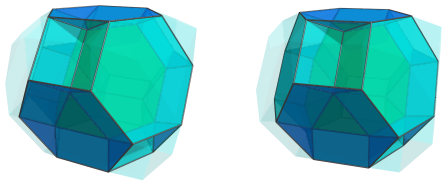
These triangular cupolae look flattened because they lie at an angle to the 4D viewpoint. However, this is merely an artifact caused by the projection into 3D. They are undistorted Johnson solids in 4D.
The gaps between each pair of hexagonal prisms are where the main cells of interest lie: the 6 gyrobifastigium cells, shown below.
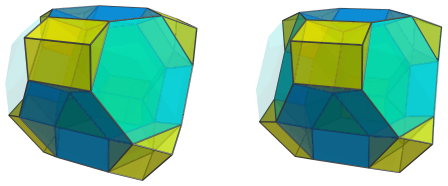
The exposed hexagonal faces of the hexagonal prisms are joined to 4 more truncated tetrahedra:
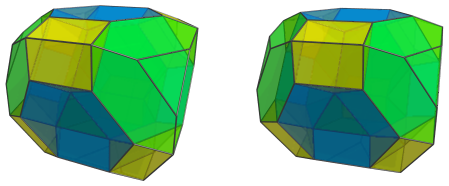
These are all the cells that lie on the near side of the polytope. The remaining cells lie on the far side.
The Far Side
On the far side, opposite the original truncated tetrahedron we started with, lies another truncated tetrahedron in dual orientation:
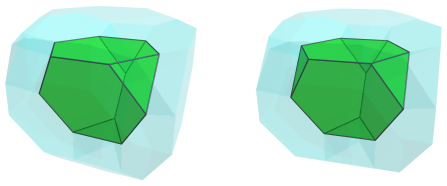
Four triangular prisms bridge this truncated tetrahedron to the last 4 truncated tetrahedra we just saw on the near side:
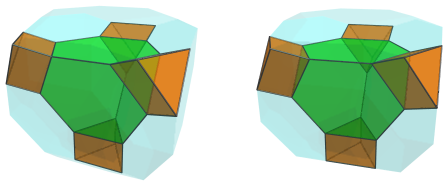
The hexagonal faces of this farthest truncated tetrahedron are joined to 4 truncated octahedra:
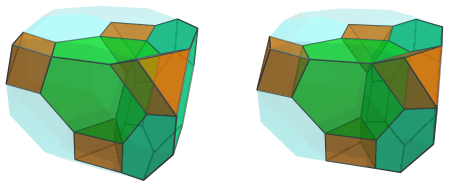
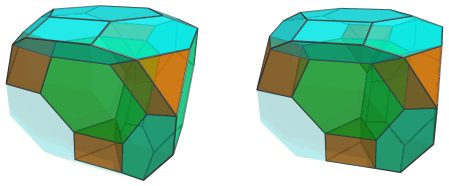
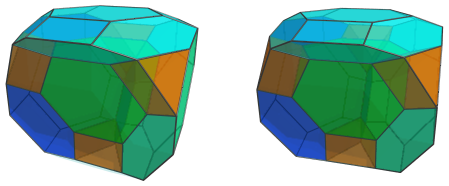
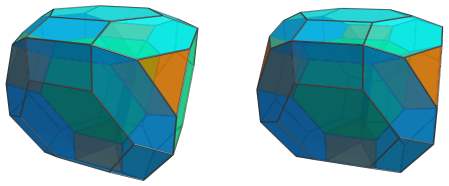
These truncated octahedra look squished because they lie at an angle to the 4D viewpoint and therefore have been foreshortened. In 4D they are undistorted, uniform truncated octahedra. The pairs of adjacent square faces between each pair of truncated octahedra are where they are joined to the gyrobifastigium cells on the near side.
Summary
These are all the cells of the augmented cantitruncated 5-cell. The cell counts are summarized in the table below:
| Region | ||||||
|---|---|---|---|---|---|---|
| Near side | 5 | 0 | 4 | 4 | 6 | 0 |
| Far side | 1 | 4 | 0 | 0 | 0 | 4 |
| Grand total | 6 | 4 | 4 | 4 | 6 | 4 |
| 28 cells | ||||||
Other Projections
The above structural projections of the augmented cantitruncated 5-cell mainly show the overall structure of the polytope and its close relation to the 5-cell symmetry from which it derives. However, it doesn't emphasize very much the primary cells of interest: the gyrobifastigia. So, here's a different projection of the polytope, centered on one of the 6 gyrobifastigia:
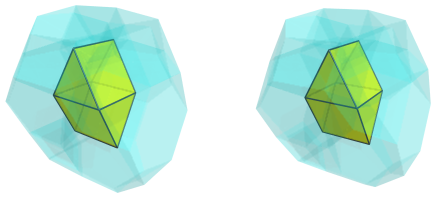
The upper two square faces of this gyrobifastigium cell are joined to 2 hexagonal prisms:
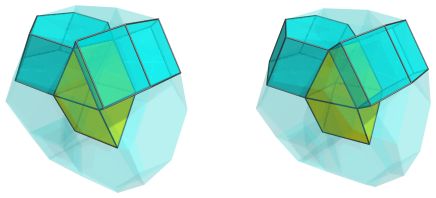
These hexagonal prisms look somewhat squished, because they lie at an angle to the 4D viewpoint.
The bottom two square faces of the gyrobifastigium are joined to two truncated octahedra:
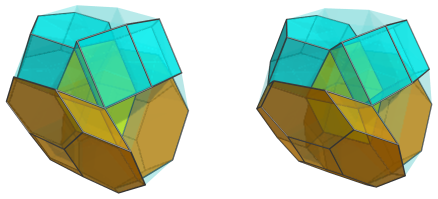
These truncated octahedra lie at a rather steep angle to the 4D viewpoint, and thus appear quite flattened. They touch each other at a shared hexagonal face below the bottom edge of the gyrobifastigium.
The upper two triangular faces of the gyrobifastigium are joined to the sides of two triangular cupolae:
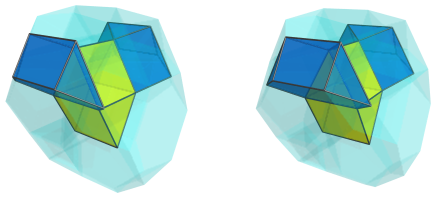
For the sake of clarity, we omit the other cells besides the gyrobifastigium itself. And finally, its bottom two triangular faces are joined to two truncated tetrahedra:
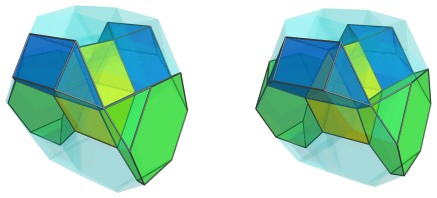
A third truncated tetrahedron sits between the hexagonal prisms we saw earlier, on top of the top edge of the gyrobifastigium:
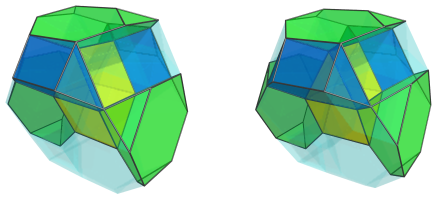
Here are all the cells surrounding the gyrobifastigium shown together:
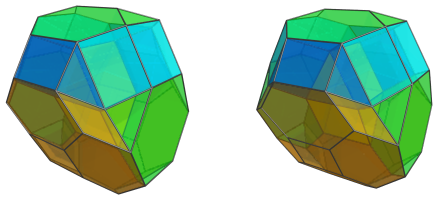
Since the 6 gyrobifastigium cells are symmetric with respect to each other, the same arrangement of cells as shown above applies to each one of them.
Coordinates
The Cartesian coordinates of the augmented cantitruncated 5-cell, having edge length 2, are:
- ±( 1/√2, 1/√2, 3/√2, −√10)
- ±( 1/√2, −1/√2, −3/√2, −√10)
- ±(−1/√2, 1/√2, −3/√2, −√10)
- ±(−1/√2, −1/√2, 3/√2, −√10)
- ±( 1/√2, 3/√2, 1/√2, −√10)
- ±( 1/√2, −3/√2, −1/√2, −√10)
- ±(−1/√2, 3/√2, −1/√2, −√10)
- ±(−1/√2, −3/√2, 1/√2, −√10)
- ±( 3/√2, 1/√2, 1/√2, −√10)
- ±( 3/√2, −1/√2, −1/√2, −√10)
- ±(−3/√2, 1/√2, −1/√2, −√10)
- ±(−3/√2, −1/√2, 1/√2, −√10)
- (0, ±√2, ±2√2, −√(5/2))
- (±√2, 0, ±2√2, −√(5/2))
- (±√2, ±2√2, 0, −√(5/2))
- (0, ±2√2, ±√2, −√(5/2))
- (±2√2, 0, ±√2, −√(5/2))
- (±2√2, ±√2, 0, −√(5/2))
- ( 1/√2, 1/√2, −5/√2, 0)
- ( 1/√2, −1/√2, 5/√2, 0)
- (−1/√2, 1/√2, 5/√2, 0)
- (−1/√2, −1/√2, −5/√2, 0)
- ( 1/√2, 5/√2, −1/√2, 0)
- ( 1/√2, −5/√2, 1/√2, 0)
- (−1/√2, 5/√2, 1/√2, 0)
- (−1/√2, −5/√2, −1/√2, 0)
- ( 5/√2, 1/√2, −1/√2, 0)
- ( 5/√2, −1/√2, 1/√2, 0)
- (−5/√2, 1/√2, 1/√2, 0)
- (−5/√2, −1/√2, −1/√2, 0)
- ( √2, √2, −2√2, √(5/2))
- ( √2, −√2, 2√2, √(5/2))
- (−√2, √2, 2√2, √(5/2))
- (−√2, −√2, −2√2, √(5/2))
- ( √2, 2√2, −√2, √(5/2))
- ( √2, −2√2, √2, √(5/2))
- (−√2, 2√2, √2, √(5/2))
- (−√2, −2√2, −√2, √(5/2))
- ( 2√2, √2, −√2, √(5/2))
- ( 2√2, −√2, √2, √(5/2))
- (−2√2, √2, √2, √(5/2))
- (−2√2, −√2, −√2, √(5/2))




